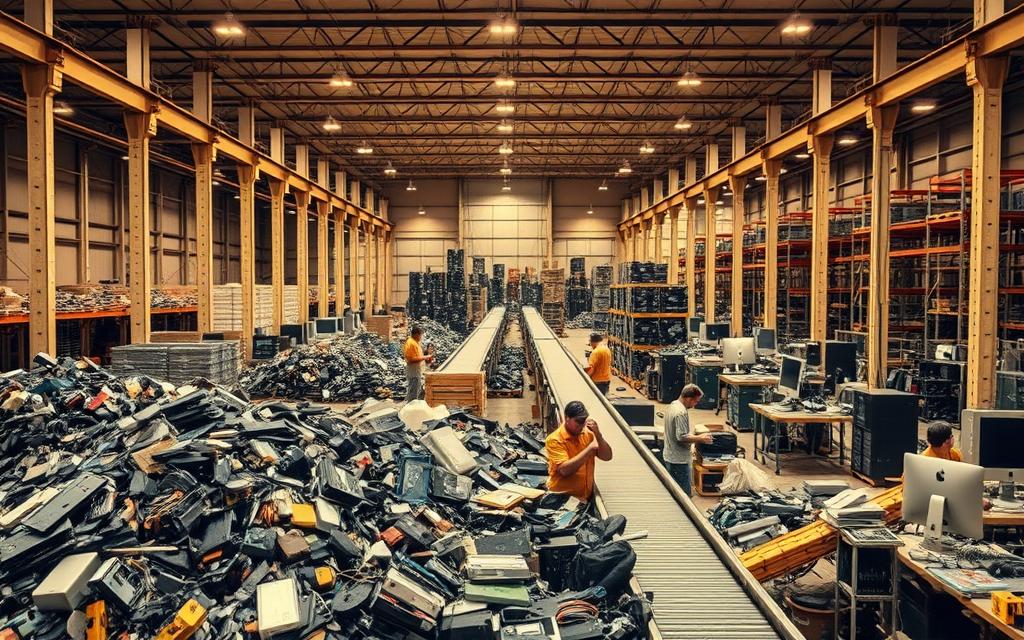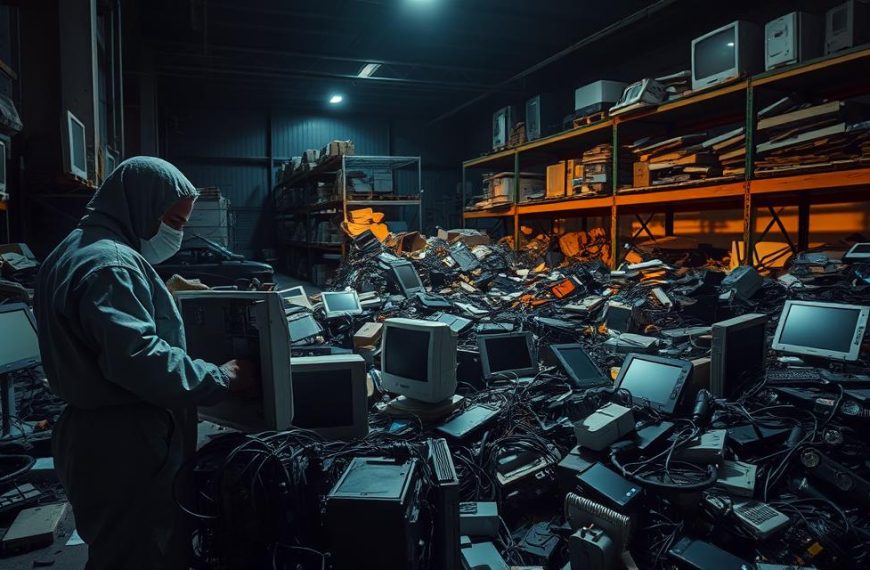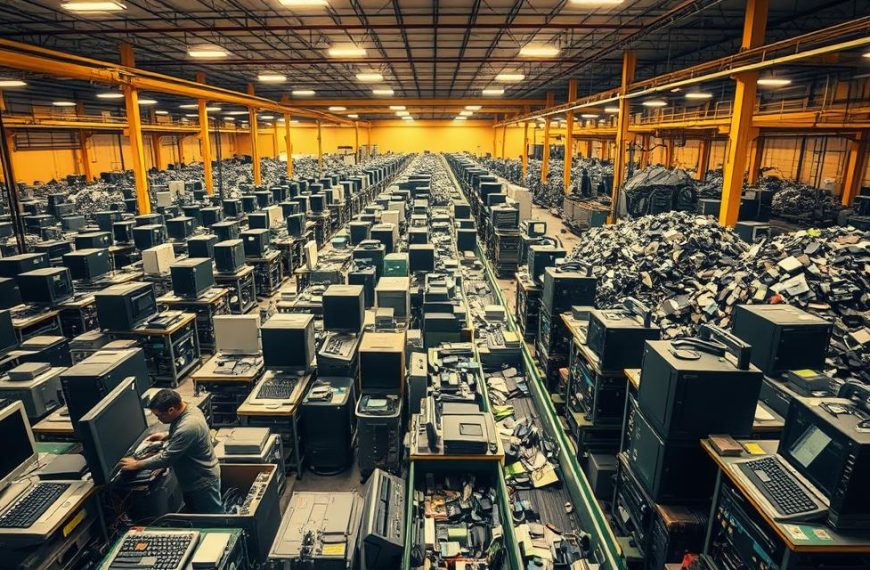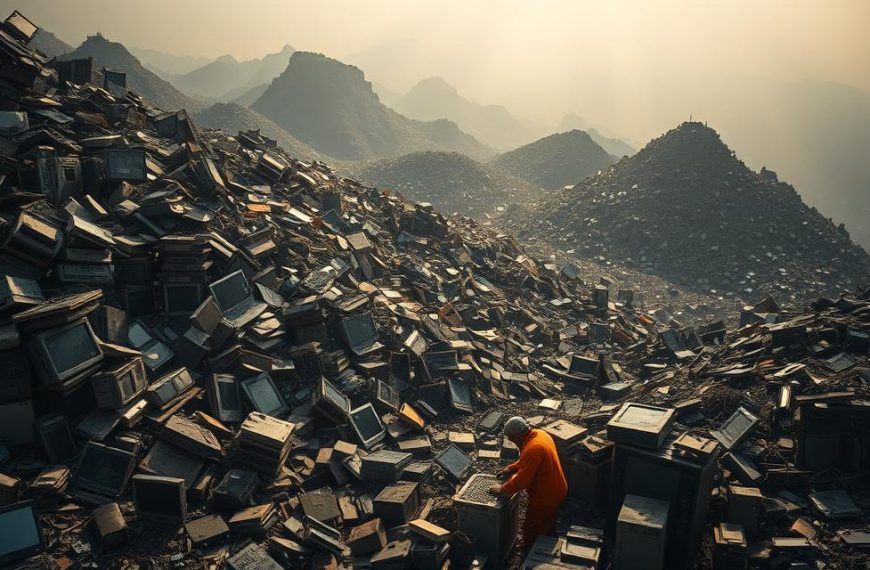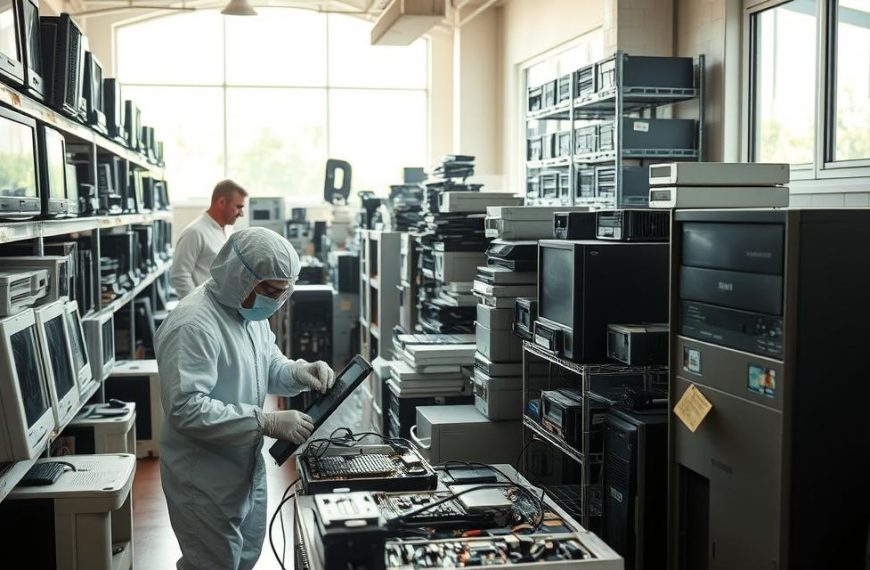In our fast-changing digital world, old electronic devices pile up quickly. This makes electronic waste management a big issue. We need special services more than ever.
E-waste is the fastest-growing waste type globally, making up nearly 70% of all toxic waste. This is due to new tech and shorter product lives.
A PC recycler deals with computers, laptops, and their parts. They offer key IT asset disposal services. This includes collecting, sorting, and recovering materials.
They make sure harmful parts don’t harm our planet. And they give old materials a new life. Good e-waste recycling is key for sustainable business today.
Understanding the PC Recycler’s Role
PC recyclers are key players in our digital world. They turn old electronics into valuable resources. These experts carefully dismantle and process electronic gear.
They start where we stop using our devices. A certified recycler doesn’t just throw away equipment. They give it a new life through careful processing.
The main job of a e-waste handler is to manage dangerous materials safely. Computers have harmful substances like lead and mercury. These need special handling.
These substances are risky for people and the planet if not handled right. Professional recyclers use strict methods to handle these dangers.
Following rules is also key for them. Good recyclers follow global standards like:
- The WEEE Directive (Waste Electrical and Electronic Equipment)
- The Basel Convention on hazardous waste movements
- Local environmental protection laws
Certifications show a recycler’s dedication to quality. Top marks include e-Stewards and R2 (Responsible Recycling) certifications.
These marks prove recyclers meet high standards. They focus on:
| Certification Aspect | Environmental Protection | Worker Safety | Data Security |
|---|---|---|---|
| e-Stewards Standard | Prevents export to developing countries | Comprehensive safety protocols | Stringent data destruction requirements |
| R2 Standard | Focuses on material recovery | OSHA compliance required | Data sanitisation protocols |
| Common Requirements | Proper hazardous waste handling | Personal protective equipment | Audit trail documentation |
The economic benefits of recycling are huge. Recyclers get valuable metals like gold and copper from old devices.
This process cuts down on mining harm. It saves natural resources and helps industries use recycled materials.
Choosing a certified recycler supports green business. It helps the economy and protects the environment.
Recycling computers is a step towards caring for our planet. This responsible recycling stops pollution and saves resources for the future.
The job of a e-waste handler is more than just getting rid of old tech. They are key to a greener tech future.
The Scale and Impact of Electronic Waste
The growing tide of discarded electronics is a major environmental challenge. It’s important to understand the volume and types of waste. This knowledge helps in creating effective recycling plans.
Current global e-waste statistics show a worrying trend. About 50-60 million tonnes of electronic devices are thrown away each year. This number is rising as more people use new technology.
These discarded devices contain valuable resources and harmful substances. They have metals like gold, silver, and copper. They also have dangerous materials like lead, mercury, and cadmium.
Handling these devices wrongly has a big environmental impact. If they go to landfills, toxic substances can get into soil and water. This harms ecosystems and human health.
Another problem is incinerating e-waste. It releases harmful particles and chemicals into the air. This worsens air quality and causes breathing issues in nearby areas.
The economic loss is also huge. Billions of dollars worth of materials are lost each year. This is both an environmental failure and a missed economic chance.
| Material Type | Annual Volume in E-Waste | Recovery Potencial | Environmental Risk |
|---|---|---|---|
| Precious Metals (Gold, Silver) | ~320 tonnes | High value recovery | Low if properly handled |
| Base Metals (Copper, Aluminium) | ~17 million tonnes | Excellent recycling rate | Moderate processing impact |
| Hazardous Materials (Lead, Mercury) | ~2.2 million tonnes | Containment critical | Severe contamination risk |
| Plastics & Composites | ~12 million tonnes | Variable recovery options | Persistent pollution concern |
Developing nations often face the biggest challenges in dealing with e-waste. Many informal recycling sites in these areas lack safety measures. This puts workers and communities at risk.
We need to act fast to improve recycling efforts. It requires global teamwork, new technologies, and raising awareness about disposing of electronics correctly.
The E-Waste Recycling Process: A Detailed Breakdown
The journey from old electronics to new materials is complex. It uses careful handling and advanced technology. This ensures we get the most from resources while keeping the environment and data safe.
Collection and Logistics
E-waste collection starts with organised systems. Recyclers use bins at key spots or take back from manufacturers. Businesses with lots of electronics get special collection services.
Transporting items is done carefully to avoid damage and contamination. Vehicles have special systems to keep things safe. Every item is tracked from start to finish, ensuring everything is accounted for.
Initial Sorting and Manual Dismantling
The first step is manual sorting by experts. They sort devices by type and condition. They remove harmful parts like batteries and toner cartridges right away.
Then, they dismantle items by hand. This way, they can get reusable parts and make sure materials go to the right places.
Data Sanitisation Techniques
Data security is a top priority. Recyclers use different data destruction methods for each device. They use software to wipe data, making it unrecoverable.
For devices that can’t be wiped, they use physical destruction. Hard drives are shredded, and magnetic data is erased. They provide certificates to prove data destruction.
Material Separation and Recovery
After data wiping, devices go through mechanical processing. Shredders break them down into uniform pieces. Then, advanced systems sort materials by type.
Magnetic and eddy current systems separate metals. Water and optical sorting identify plastics. This way, over 95% of materials are reused.
Managing Hazardous Substances
Handling hazardous waste is key to responsible recycling. Facilities isolate toxic materials like mercury and lead. They follow strict environmental rules.
Toxic parts are disposed of safely. Recycling facilities use filters to keep the air and water clean. This protects the environment throughout the process.
Advantages of Responsible Electronics Recycling
Responsible electronics recycling offers big benefits beyond just managing waste. When companies work with certified recyclers, they help turn waste into valuable resources.
The benefits of e-waste recycling for the environment are huge. It stops toxic stuff like lead and mercury from harming our soil and water. This keeps our ecosystems and health safe.
Recycling also saves resources. Electronics have valuable metals like gold and silver. Recycling gets these materials back to us efficiently.
“Electronic waste is a big challenge and a chance for economic growth. When recycled right, it becomes a treasure, not a problem.”
Good recycling also helps the economy. Companies that use recycled materials save money. This means cheaper products for us.
Recycling also creates jobs. It needs people to sort, transport, and process waste. These jobs help local economies and protect the environment.
Recycling also saves energy. Making new products from recycled materials uses less energy than mining. This cuts down on carbon emissions.
The biggest win is moving to a circular economy. This means products are made to be recycled, not thrown away. It’s a big step towards using resources wisely.
| Advantage Category | Specific Benefits | Quantifiable Impact |
|---|---|---|
| Environmental Protection | Reduced toxin release, conservation of natural habitats | Prevents soil and water contamination |
| Resource Management | Recovery of precious metals, reduced mining needs | Conserves finite natural resources |
| Economic Value | Lower manufacturing costs, job creation | Supports green employment opportunities |
| Energy Efficiency | Reduced energy consumption in material processing | Lowers carbon footprint significantly |
Being socially responsible is another big plus. Companies that recycle well get a better reputation. People like to buy from companies that care about the planet.
The circular economy is all about being responsible. Making products that can be recycled is the future. It’s how we’ll make and dispose of electronics.
Looking after resources for the long term is key. Electronics have parts that are hard to find. Recycling makes these parts last longer.
In the end, recycling electronics is a win-win. It protects the environment, helps the economy, and shows we care about the planet. It’s a big step towards a better future.
This way of recycling is not just good for the planet. It’s also good for business. It’s a chance to make money while protecting our resources.
Selecting a Certified PC Recycler in the United States
Finding the right partner for electronic waste disposal is key. The United States has strict US recycling standards. These standards protect the environment and keep data safe during disposal.
Look for recyclers with R2 certification or e-Stewards accreditation. These certifications show they recycle responsibly. They handle hazardous materials well and manage recovered materials ethically.
- Transparency in their recycling chain and final destination reporting
- Comprehensive data destruction methods and certification
- Environmental compliance documentation and audit reports
- Experience with your specific type and volume of equipment
State laws also play a role. California and New York have their own rules for e-waste recycling. A good certified e-waste recycler knows these laws and follows them.
Big tech companies also have recycling plans. For example, IBM’s product recycling programmes work with certified recyclers. These plans show how companies handle old tech responsibly.
Do your homework before choosing a recycling partner. Check certifications on the R2 or e-Stewards websites. Ask for references and look at their environmental record.
The best recycling partner will share their process details. They should have data destruction certificates and material tracking reports. This openness helps your organisation meet environmental and data protection goals.
Conclusion
PC recyclers are key in tackling our global e-waste problem. They turn harmful waste into valuable resources. Their work helps our planet and boosts the economy.
It’s important for everyone to recycle electronics responsibly. Choosing certified recyclers is a must. They handle hazardous materials safely and protect data for businesses.
Improving recycling needs new ideas and more facilities. Extended producer responsibility helps make products easier to recycle. This way, we can make electronics that are good for the planet from start to finish.
As recycling gets better, we’re moving towards a greener future. Our aim is to cut down waste and use resources wisely. Together, we can make sure future generations have a clean planet.

